-
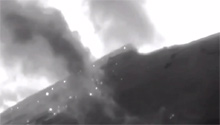
Los Ingrávidos
Infrarrojo/ Reclamos de la tierra - (4:19)
After the massacre of 18 May 1967, perpetrated by the Mexican government against teachers and farmers in Costa Grande de Guerrero, rural teacher Lucio Cabañas Barrientos sparked one of Mexico’s biggest armed uprisings, which stands out today for its resonance and topicality with all the power of an erupting volcano.
-
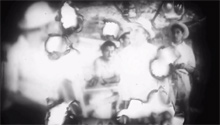
Los Ingrávidos
Abecedario/ B - (4:55)
Cinema under fire. The relation between a shooting and the image changes somewhat: rather than showing the representation of a shooting 24 frames per second, whether acted or documented, the celluloid is the direct bearer, the target, the victim of the shots in each still. It ceases to be the smooth surface on which 24-frame action is printed to become the affected surface, each still supporting the reality that this is a bad time for the cinema. The celluloid has to be put into a trance, forcing it to suffer the sound itself.
-
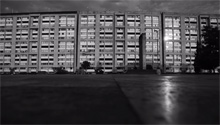
Los Ingrávidos
2 de octubre/ Lejos de Tlatelolco - (4:05)de Tlatelolco - (4:05)
The theme is the massacre organized by the Mexican government on 2 October 1968 at a residential complex, aimed at young unarmed students on a utopian demonstration. The image of Tlatelolco’s historic pre-Columbian square and its residential complex contrasts with the voiceover that asks “Who was behind this?” and poses the open question “Who is responsible for the silence? Who continues to impose it?”. The singular acousmatics* of the soundtrack indicates a voice that remains remote from a happening that is impossible to interiorize; though distant, it produces the narrative of an event that should never have happened.
*Note: acousmatics is a term used in audiovisual language to refer to the separation or dissociation between the sound object and its source, when we intentionally separate the two, as in this video.
-
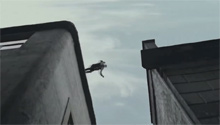
Los Ingrávidos
Falso movimiento - (1:43)
This forms part of the “Intervenciones” series. Falso movimiento is a criticism of the government and paramilitarization.
-
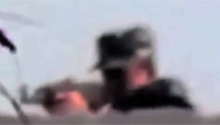
Los Ingrávidos
Francotirador/ La mirada cautiva (1:17)
Between the hawk-like gaze of a sniper and the expectant contemplation of the documentary camera operator lies a breach in which an evanescent gaze is suspended, belonging to neither, the captive gaze flashes with an internal monologue as it disappears. This look occupies the non-places that emerge from constant battles, from endless wars.
-
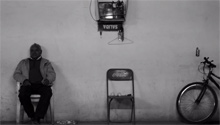
Los Ingrávidos
Abecedario/ Q - (7:26)
This video looks at the remains, preparation and emergence of a Quermés, a popular open-air festival that celebrates music and dance, marking the start of the commemoration of Mexican Independence but also the Mexican Revolution. Yet the atmosphere of reverie, of drowsiness, evokes the presence of an increasingly acute realization that we are looking at the remains, the leftovers, the wreckage, of the celebration. Independence and Revolution are dispersed in the reverie of a drunken spree.
-
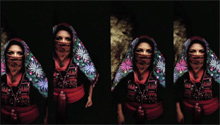
Los Ingrávidos
Zapatista/ Música en el vientre - (8:41)
On 1 January 1994, the Zapatista Army of National Liberation EZLN burst forth with the violence of a new event, a call for a necessary political transformation and a form of life that emerges from the land. The ringing bells call not only for a popular uprising; they also call for a return to origins, to the primeval waters, the eternal womb where life calls out for life.
-
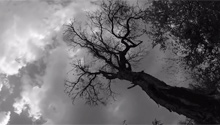
Los Ingrávidos
Abecedario/ R (12:09)
This video builds a bridge between the sensitive, inhuman experience of the earth and the human perception that is gradually integrated in the immanence of the random movement of nature. A perceptive odyssey inspired by Itinéraire de Jean Bricard (Straub-Huillet) and La région centrale (Michael Snow).
-
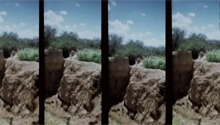
Los Ingrávidos
Soldadera/ Percusión visual - (5:50)
A conceptual character lifted from the Mexican Revolution, a female armed militant who sees the immanence of a life in the landscapes through which she passes and in which she becomes a singularity that emerges from the event: the immanent life of a woman soldier. Finally, she brings us into contact with the beating heart of the country in Mexico, a cascade of colours and paths, in the steps of a woman who aspires to make her voice heard in the unceasing struggle.
-
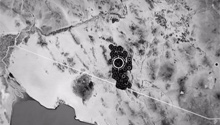
Los Ingrávidos
Entropia blanca. Díptic / Abecedario X,Y (57:06)
[Audiovisuals only for online exhibition]
This is an audiovisual cartography that brings to light one of the different and lamentable consequences of the US’s infamous migration policy. The film is the product of the need to give visibility to events that are gradually faded out by international bureaucracy.
It forms part of a series that aims to reassign to each letter of the alphabet an audiovisual function that hangs on a singular collective imaginary
-

Los Ingrávidos
Entropia blanca. Díptic / Hipertermia (29:25)
[Audiovisuals only for online exhibition]
This is the effect of white entropy given off by Abecedario/X, Y on celluloid. Entropy is found or calculated by directing and integrating the energy that introduces chaos into a closed system. Energy that is not recovered introduces disorder.
All fires the fire
“… truth, whose mother is history, rival of time, depository of deeds, witness of the past, exemplar and adviser to the present, and the future’s counsellor.”
Pierre Menard. Don Quixote, part one, chapter IX
Nine individual parts for a war machine outside the State apparatus. Pure multiplicity, of unclear size, exteriority confirmed by mythology, fabulation, drama, festivals and infrarealism. The irruption of the ephemeral and the power of metamorphosis. In the face of measure, wielding fury; in the face of gravity, celerity; in the face of the political, a secret; in the face of sovereignty, power; in the face of apparatus, a machine.
Individual parts to highlight another justice, sometimes of incomprehensible cruelty, but sometime also of unknown compassion. Above all to highlight other relations, since everything connects in future potential relations, rather than creating binary relations between “states”: an animal-becoming of the warrior, a volcano-becoming of the people who are missing.
The nine parts evoke a war to come, but it is not an institutionalized, regulated, codified war, with a front, a rearguard and battles. On the contrary, it is a war with no line of combat, no confrontation and no rearguard—ultimately a war with no battle: pure strategy.
What renews the strategy is a multitude of questions in a precise form that queries the time of a diffuse action, already past and yet to come, of a fire that brings to life all the incomplete figures that make it up, a proliferation of questions that ask:
– What happened to make a volcano call for a war to come in the singular voice of the masses and of the people that are missing? [Infrarrojo/Reclamos de la tierra]
– What can have happened to disjoint celluloid and its rhythm, and to cause the delicate phylum of the image to be continually shot at, manifesting its original and precarious but no less lovely materiality? [Abecedario/B]
– Where does the other, foreign neutral voice come from to render legible and audible a terrible event that has been interpreted over and over by habit and tradition until it has lost all content? [2 de octubre/Lejos de Tlatelolco]
– What has happened to enable us to glimpse, amid government propaganda, another violence, that of a vast war machine growing inside the “amicable image” of itself that the State apparatus wishes to present? [Falso movimiento]
– What does the gaze capture in the moment of its suppression? [Francotirador/La mirada captiva]
– What has happened to enable the silence of a letter turn a festival into a continual dance of depleted shadows, remnants of celebration? [Abecedario/Q]
– What has happened to allow a weightless perception make its way between random rotations and burned mythologies? [Abecedario/R]
– What can have happened to make us, in the shadow of the consuming fire, insist on calling for the pertinence of certain weapons to the immanence of a life, an oscillating machine of war outside the State apparatus, fractal perception of a Soldadera and a Zapatista that have been, yet have not taken place? [Zapatista/Música en el vientre] [Soldadera/Percusión visual]
Finally, whatever the calls or claims, we have to partake in the risk of suffering time as a pure form of destitution. To litigate celluloid as a surface that is neither simple nor smooth. A body that is hit and harassed by the singular holes of entropy. To derail the 24 frames to show that each engram bears the embodiment of Time and the Idea in its least pleasing form. To make the celluloid crawl and mobilize it with the disheartened pulse of danger. To join the debris that the Angelus Novus contemplates and to assign to the rubbish of progress its status of transitory evidence. Briefly to repeat the example of the fires in Alexandria and the Mexican national film archive, to make the moment of danger, of a flare-up, reveal the non-partial fate of memory.
Los Ingrávidos collective, Mexico 2014
Collective’s website: http://losingravidos.com/
We are an outpouring via memory. Mob. Stampede. Immersion. Diaspora. A hole in your pocket. A phantasm that refuses to leave you. We are that invasion. A body made up of whispers. A body that does not appear, that no one wants to mention.
Here, we are all limbo.
Is there a common theme, approach or intention running through the pieces you’ve selected for this programme? What is the meaning of the separating slash in the titles?
More than positing a similarity running through the pieces in the programme, our aim is to address or question the conditions of their emergence, circumstances that prompt the coexistence and development of different audiovisual devices in the conception of fire, armed uprisings and grassroots resistance that emerge to counter the escalating military intervention and the arms race that have devastated Mexico in recent years. The different devices proposed seek to counter the hegemonic representation of violence. The separating slash picks up Harun Farocki’s idea of differentiating between form and content within the audiovisual device or regime, at the same time establishing the principle of its synthesis. For example, in “Infrarrojo/Reclamos de la Tierra”, the visual form is determined by an image filmed in infrared, while the auditory theme establishes the intention of denunciation and grievance which, finally, generates the heuristic meaning of the piece. Not forgetting the resonance of the term “Infrared”; far from being a purely technical demarcation (a shot taken in infrared), it refers to the way the armed uprising led by rural teacher Lucio Cabañas Barrientos was classified: Infrared.
A motif running through much of your work is of course violence, in the form of sound (with harsh accounts of executions, for example) and visuals, but here metaphorically, by means of a volcanic eruption or the destruction of the frame.
The hegemonic representation of violence is based on a lamentable assumption: the sound is subsumed in the image. The unfortunate corollary of this audiovisual regime is that the official sound discourse can only take precedence over the image when the aim is to make the “real content” that any image supposes legible to an “ideal spectator”. In contrast with this atrocious course, our works are based on heterogeneity and on the autonomy that exists between visual image and sound image.
This is fundamental to developing the various possible relations between image and sound, relations that become paradoxical and complicate the perceptual domain of the spectator.
Tell us something about the title you’ve given this programme, All Fires the Fire, and the name of your collective, Los Ingrávidos.
The title of the programme is in resonance with the short story of the same name by Julio Cortázar. What we’re interested in is evoking the simultaneity that structures Cortázar’s story and allows us to modulate the construction of audiovisual devices in keeping with the theme of armed uprisings, violence and the destructive potential of fire. The collective’s name, Los Ingrávidos, vindicates the phantasmal nature of sound and the auditory image, the subtlety that permeates voices and heterogeneous floating noises that cannot be reduced to a recognisable corporality. A corporal cluster that only appears in the iridescence of the destruction of visual surfaces.
You quote Jonas Mekas in your manifesto. Has his cinema influenced you?
Not just his cinema; his diaries, too. The way he thinks and makes cinema from a point inside a constant battle against audiovisual hegemony inspires us to resist and continue.
Los Ingrávidos, Mexico 2014
To mark the return of Pantalla CCCB, we present Los Ingrávidos, a collective of three young video artists with links to the Infrarrealistas (Bolaño and Papasquiaro), a literary group enamoured of the precarious, that which is never actually voiced.
Their videos contain things that neither are nor mean what they appear. The work of Los Ingrávidos is sometimes densely political, centring on Mexico’s highly complex society. Their universe is made up of trees, rivers and fields, peasant farmers and popular festivals; but also of empty spaces in places that have seen executions, fires in kindergartens, erupting volcanoes, audios of hit men who record their killings. Their themes include the disproportionate repression of popular protests, immigration, media manipulation and everyday executions that compete in bloody spectacularity.
There are things that have never been easy to represent fairly, things that are somehow unknown, ungraspable. They are, perhaps, some of the ones that sadly are most frequently and most poorly represented: violence, sex, death, happiness… Things that are difficult because the attempt to represent them rigorously, not trivially, always falls short, though we are not quite sure how. Los Ingrávidos are conscious of the general abuse of trivial representation and want their images to make us think.
“We want to generate a state of questioning in viewers, to make them wonder what has happened. We want to make sure that these struggles, these acts of resistance, don’t fall through the cracks.” Sometimes they play with the contrast between abstract images and voices that are taken from or talk about horrible things, backed by music that seems to invite reflection. “Television diseases the viewers’ eye, turning them into passive viewers”, they say. They are also interested in the materiality of images, different supports and a different kind of narration—when there is one—to the conventional forms.
Deconstructing the misleading images that are produced by the mass media in cahoots with whichever government happens to be in power, dismounting the apparatus behind their manipulating rhetoric, attempting to show up their lies. Using recordings from the past aims to reactivate political discourses and apply them to today’s reality. In the face of the supposed neutrality of images, which are always permeated by ideology, Los Ingrávidos set out to reconnect old injustices with the present.
Fèlix Pérez-Hita [ Video artist and cultural critic ]












